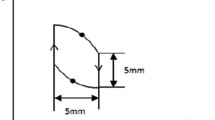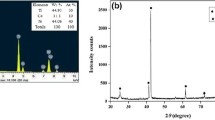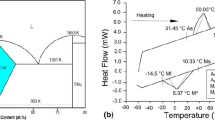Abstract
This study considers the effect of wire electro discharge machining (WEDM) parameter peak current (Ip) and pulse peak voltage (Vp) on the machined surface morphology of TiNiCu shape memory alloys. Various defects of machined surfaces were identified and correlated with parameter values and measured average surface roughness (Ra) and average surface depth (Rz). It was found that the nature of the machined surface is highly influenced by the nature of sparking, which is dictated by levels of peak current and peak voltage used during machining. Distinctions between machining parameters resulting in “rough-cut” and “trim-cut” machining are reported along with deviations in output responses, which counters the trend reported in the literature.
Similar content being viewed by others
Abbreviations
- Ip :
-
Peak current
- Vp :
-
Peak voltage
- Ra :
-
Average surface roughness
- Rz :
-
Average surface depth
- Ton :
-
Pulse on duration
- Toff :
-
Pulse off duration
- SV:
-
Servo voltage
- WF:
-
Wire feed rate
References
F. J. Gil, E. Solano, J. Pena, E. Engel, A. Mendoza and J. A. Planell, Microstructural, mechanical and citotoxicity evaluation of different NiTi and NiTiCu shape memory alloys, Journal of Materials Science: Materials in Medicine, 15 (11) (2004) 1181–1185.
H. F. Li, K. J. Qiu, F. Y. Zhou, L. Li and Y. F. Zheng, Design and development of novel antibacterial Ti-Ni-Cu shape memory alloys for biomedical application, Scientific Reports, 6 (2016).
M. Manjaiah, S. Narendranath and S. Basavarajappa, Review on non-conventional machining of shape memory alloys, Transactions of Nonferrous Metals Society of China, 24 (1) (2014) 12–21.
A. Pramanik and A. K. Basak, Effect of wire electric discharge machining (EDM) parameters on fatigue life of Ti-6Al-4V alloy, International Journal of Fatigue, 128 (2019) 105186.
A. Roy and S. Narendranath, Impact of variation in wire electro discharge machining responses of homologous TiNiCu shape memory alloys for smart applications: An experimental investigation, Materials Research Express, 5 (12) (2018) 125701.
A. Roy and S. Narendranath, Effect of spark gap voltage and wire electrode feed rate on machined surface morphology during Wire EDM process, Materials Today: Proceedings, 5 (9) (2018) 18104–18109.
A. Roy, S. N. Nath and D. Nedelcu, Experimental investigation on variation of output responses of as cast TiNiCu shape memory alloys using wire EDM, International Journal of Modern Manufacturing Technologies, 9 (1) (2017) 90–101.
A. Ikram, N. A. Mufti, M. Q. Saleem and A. R. Khan, Parametric optimization for surface roughness, kerf and MRR in wire electrical discharge machining (WEDM) using Taguchi design of experiment, Journal of Mechanical Science and Technology, 27 (7) (2013) 2133–2141.
S. Sarkar, S. Mitra and B. Bhattacharyya, Parametric analysis and optimization of wire electrical discharge machining of γ-titanium aluminide alloy, Journal of Materials Processing Technology, 159 (3) (2005) 286–294.
S. S. Mahapatra and A. Patnaik, Optimization of wire electrical discharge machining (WEDM) process parameters using Taguchi method, International Journal of Advanced Manufacturing Technology, 34 (9–10) (2007) 911–925.
L. Li, X. T. Wei and Z. Y. Li, Surface integrity evolution and machining efficiency analysis of W-EDM of nickel-based alloy, Applied Surface Science, 313 (2014) 138–143.
S. F. Hsieh, A. W. Hsue, S. L. Chen, M. H. Lin, K. L. Ou and P. L. Mao, EDM surface characteristics and shape recovery ability of Ti35.5Ni48.5Zr16 and Ni60Al24.5Fe15.5 ternary shape memory alloys, Journal of Alloys and Compounds, 571 (2013) 63–68.
M. Gostimirovic, V. Pucovsky, M. Sekulic, M. Radovanovic and M. Madic, Evolutionary multi-objective optimization of energy efficiency in electrical discharge machining, Journal of Mechanical Science and Technology, 32 (10) (2018) 4775–4785.
K. Mouralova, L. Benes, J. Bednar, R. Zahradnicek, T. Prokes, R. Matousek and J. Otoupalik, Using a DoE for a comprehensive analysis of the surface quality and cutting speed in WED-machined hadfield steel, Journal of Mechanical Science and Technology, 33 (5) (2019) 2371–2386.
J. Y. Gwon, S. H. Jang, W. T. Kwon and Y. W. Kim, Micro electrical discharge drilling characteristics of conductive SiC-Ti2CN composite, Journal of Mechanical Science and Technology, 32 (7) (2018) 3351–3358.
Acknowledgments
This work was supported by the DST-SERB, Government of India under sanction no. SB/S3/MMER/0067/2013. Authors would like to express their gratitude for funding this research work.
Author information
Authors and Affiliations
Corresponding author
Additional information
Abhinaba Roy is a research scholar in Mechanical Engineering at National Institute of Technology Karnataka, India. His research interests include conventional and non-conventional machining processes, materials science and tribology.
Narendranath S. is a Professor and former HOD of Mechanical Engineering at National Institute of Technology Karnataka, India. His doctorate is from Indian Institute of Technology Kharagpur, India.
Alokesh Pramanik is a lecturer in Mechanical Engineering at Curtin University, Australia. His doctorate is from University of Sydney. His research interests include Machining Processes and Composite Materials.
Rights and permissions
About this article
Cite this article
Roy, A., Narendranath, S. & Pramanik, A. Effect of peak current and peak voltage on machined surface morphology during WEDM of TiNiCu shape memory alloys. J Mech Sci Technol 34, 3957–3961 (2020). https://doi.org/10.1007/s12206-020-2205-x
Received:
Revised:
Accepted:
Published:
Issue Date:
DOI: https://doi.org/10.1007/s12206-020-2205-x




